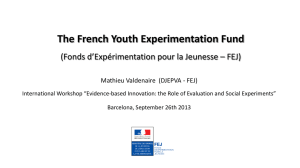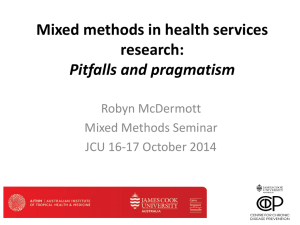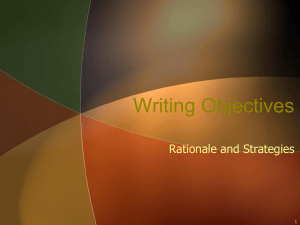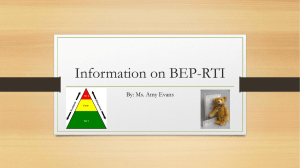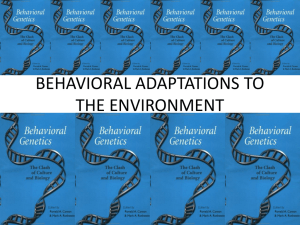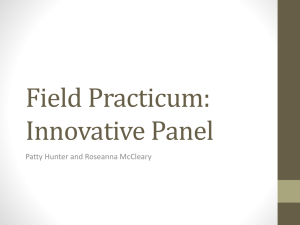10 Lessons Learned - Grameen Foundation
advertisement
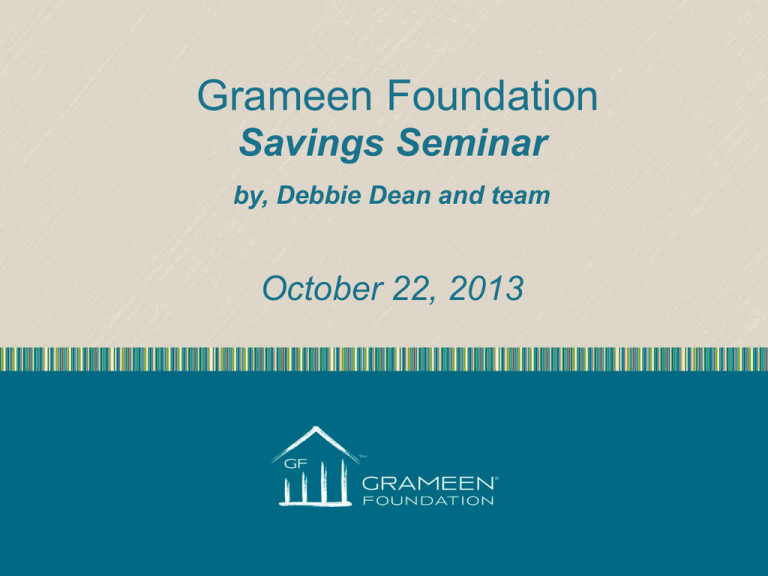
Grameen Foundation Savings Seminar by, Debbie Dean and team October 22, 2013 Agenda Overview of morning Ten lessons Breakout activities Break (around 10:30 or 11 am) Grameen Foundation Microsavings Initiative Partnering with CARD Bank, ACSI, and CASHPOR to create minimum of 650k new active savers with a target of 1.45M new savers Expand safe access to formal savings accounts ensuring a segmentation of the market includes targeting existing loan clients, non-loan clients, and low income rural savers Building a sustainable business model for the institution and the client GF is taking a holistic approach working with the MFI’s in transformation Product Design and Market Research Marketing and Financial Literacy Enabling Field Transactions Institutional Capacity Microsavings Initiative • Amhara Credit and Savings Institution (ACSI) is the largest MFI in Ethiopia founded in 1995 as an NGO project in Amhara region • 2800 employees • Offering savings since inception • ACSI received its MFI license (1997) focusing on small farmers; predominantly service agricultural loans using the group lending methodology. • 2012 outreach: • 11 Micro-banks • 203 sub-branches Cashpor • CARD Bank (1997) is a microfinance-oriented rural bank (part of CARD MRI (1986) • Largest MFI in the Philippines by more than 50% of microfinance market • 1500 employees • Organization owned, managed and controlled by women members; • Moved from group to individual lending and offering savings services since 2003 • Current reach: • 53 branches • 255 Micro Banking Offices (MBO) ACSI CARD Bank Our Financial Services Partners • Cashpor Micro Credit (1997) is MFI with a focus on women living below the poverty line in the Uttar Pradesh and Bihar regions; 1679 employees • Unique regulatory environment - banking correspondent (BC) model is the only viable path for expanding savings services • Establishing a triple win business model is key to success • Current reach: • 8 districts • 131 branches Microsavings Initiative Results Findings CARD Bank Cashpor ACSI Poverty Outreach < $2.50/day 45% 96%* 79%* < $1.25/day 15% 75%* 25%* New Pilot Product 75,534 104,065 4,839 Total Saver Growth 428,100 104,065 320,848 Very poor = $37 Poor = $102 $3.5 NA NA 29% NA NA NA Number of Savers Average Savings Balance Dormancy (>180 days) Transaction Mix based on poverty level Sample: 9,065 Matapat customers with PPI Matapat customer base: <$1.25 = 10%; <$2.50/day = 33% Opening balance on <$2.50/day <= php100: 80% >php100 is 20% * Credit clients , not savers Lesson 1 Building the Right Team Choosing the right Financial Services Partner Partner Selection Process and Tool Karla Brom Financial Risk Management Social Performance Management Marketing Role of Project Management Ruth Jacobs Financial Literacy Internal Controls Engaging with Implementation Partners Tomoko Harigaya Behavioral Research Research Human Resources and Change Management Lesson 2 Leading Organizational Change What is Change Leadership/Management Why is it important How we instituted Change • Change Workshops • Lead/Shadow/Follow Methodology • Communication Planning • Human Capital Management (HCM) Assessment Lesson 2 Human Capital Assessment Strategic Planning Leadership Practices Culture Talent Acquisition Talent Development Rewards & Recognition Review of the HR Function http://humancapitalhub.org/Human_Capital_Management_Assessment Lesson 2 Leading Organizational Change Key Lessons: Project Management = Change Leaders Build trust Use their language and work culture Baby steps -- Change takes longer than you think What would we do differently • • • • Perform the HCM assessment early Send partners top execs to leadership training Find the low hanging fruit Incorporate performance targets and incentives early CONTENT Breakout Activity a. Landscape Assessment Summary slides b. Some notes and translations from CGAP Organizational Change documents Climate c. Some notes and Assessment translations from UNDP / UNCDF Financial Inclusion Study Found onfrom humancapitalhub.org d. Information Cocoa Study by GF Lesson 3 Research – framework, RCTs, and findings Research is something you do throughout and not just a one time activity. Many ways to incorporate research into the program How do we use the findings to guide the work and do course correction Lesson 3 Research – framework, RCTs, and findings Behavioral Design Games Randomized Control led Trials (RCTs) Questionnaires Observation Paper Prototypes Surveys Sampling Landscape Focus Groups Discussions Usability Studies Innovation Impact Lesson 3 Research – framework, RCTs, and findings Behavioral Design Games Randomized Control led Trials (RCTs) Questionnaires Observation Sampling Landscape Paper Prototypes Surveys Innovation Focus Groups Discussions Impact Lesson 3 Research – framework, RCTs, and findings Cashpor • 70% illteracy rate • 20% own a phone • 60% access a phone • 20% no phone CARD • 20% preferred manual system • 48% of transactions by older members were made by someone else • Members that used the system least, paid the most Lesson 3 Research – framework, RCTs, and findings Tracking key metrics is important! Lesson 3 Research – framework, RCTs, and findings Tracking key metrics is important! Lesson 3 Research – framework, RCTs, and findings Tracking key metrics is important! Lesson 3 Research – framework, RCTs, and findings Number of Borrowers CORRECTLY ^ Tracking key metrics is important! CRITICAL! Lesson 3 Behavioral Research • Started with CARD to evaluate the uptake and usage, then found that 58% were not transacting, so refocused our work on usage. • Also started out focusing on just the new product, Matapat, then realized it was across the board that was going to have a better outcome. 19 Lesson 3 Behavioral Research • ideas42 partnered with CARD Bank and Grameen Foundation and used behavioral design and a randomized controlled trial to test the effect of applied behavioral economics to the design of savings accounts. • Clients were 60% more likely to use new savings accounts and made deposits that were 11% larger. These clients maintained larger balances than they would have otherwise. • Clients with existing accounts made larger deposits and withdrawals and increased engagement with their savings accounts • These positive results indicate CARD Bank should implement the new intervention in all branches and that behavioral design is a powerful tool for improved savings behavior. 20 Summary of the ideas42 methodology Define the problem Review behavioral research Know the Context Generate Behavioral Diagnosis Iterative Design Process RCT • Begin by carefully defining the problem in terms of a specific user behavior • Review relevant behavioral research • Develop a detailed contextual understanding – the details matter! • Diagnose behavioral bottlenecks that are preventing user behavior • Design behavioral interventions to address those bottlenecks • Test these interventions with a randomized controlled trial to measure impact. 21 Lesson 4 Product Design Product design is also never truly done and research should be incorporated throughout the product lifecycle Regulatory Litmus Test Make adjustments early and think beyond the ‘financial features’ such as the channel, tools to support the clients, etc. Approvals through a Savings Committee Concepts and Prototyping ideas before going to market with a pilot product. • Cashpor used a ‘raise the hand’ approach when designing a commitment savings account and a fixed deposit account. Lesson 5 Importance of Marketing Lesson 5 Importance of Marketing Lesson 5 Importance of Marketing BEFORE AFTER BEFORE Lesson 5 Importance of Marketing Branch Product Posters AFTER BEFORE Lesson 5 Importance of Marketing Lesson 6 IT, Data, and Reporting Loans to voluntary savings • Velocity of Information • Activation and Updates (balance inquiries) • Availability of deposits Centralized v Decentralized Systems High Availability (Redundancy, DRS) Lesson 6 IT, Data, and Reporting Lesson 6 IT, Data, and Reporting Understand the environment • What are the components and where do they reside? • What are the technical resources? Formulate what you need and when • Operational or Analytical? Set realistic expectations Lesson 6 IT, Data, and Reporting Why we push the use of data? • • • • • • • Benchmark social performance, and business and market figures To answer business questions Better understand customers needs and behaviors Uncover nuances, discover opportunities, reduce risks and costs Confirm assumptions and test hypothesis Provide inputs for business case modeling Overall, to take better informed decisions and drive change “The bottleneck is less technical and more human, not statistics but organizational change management. Accuracy is easier to achieve than adoption.” Lesson 7 Train, Train, and Train Some More Amount of training and re-training required for MFI field staff to be effective in delivery savings Perform early Skills Gap Analysis for FSP project team Many types of training required • • • • • Change management Sales & promotion Customer service Product Business Process Mobile Phone Literacy Language barriers, day of week, and lively interactive sessions are the most effective Lesson 8 Benefits of a Trusted Intermediary Lesson 8 Benefits of a Trusted Intermediary Established Relationships • ACSI - 1995 • Cashpor - 1997 • CARD - 1986 • Trust with clients • Knowledge of culture as neighbors and family members Introduce Products and Services where customers live • Weekly meetings – important interactions Lesson 8 Benefits of a Trusted Intermediary Lesson 8 Benefits of a Trusted Intermediary Lesson 9 Discipline of Project Management How the customer explained it How the project leader understood it How the engineer designed it How the programmer wrote it How the sales executive described it How the project was documented What operations installed How the customer was billed How the helpdesk supported it What the customer really needed Lesson 9 Discipline of Project Management You don’t appreciate or value PM until you have a good one! 5 Components Project Management • • • • • Managing Scope Managing Schedule and Resources Communications Risk Mitigation Budget Cross cultural implications when managing a project Lesson 10 You Can Build a Business Case Can build the business case for small savings 3 Golden Rules • Understand the present before planning the future • Rephrase questions and objectives, often • Keep it simple


